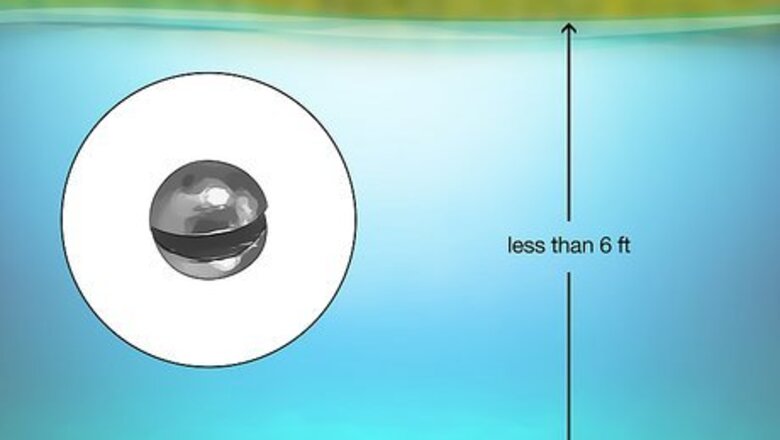
views
Split Shot Weights

Use a split shot weight for fishing less than 6 ft (1.8 m) deep. Split shot weights look like small metal balls that have a large slit on one side. Since split shot weights are lighter, they won’t pull your bait as deep as other sinkers, but they’re great for catching any type of fish in ponds, lakes, and rivers. Split shots are also easy to take on and off if you need to quickly change the weight on your line.

Position 1 or 2 weights 1–2 ft (30–61 cm) from the hook. Since you want your hook and bait to float above the weight, there needs to be a little bit of space between them. Measure up from the top of your hook and set the line inside of the large groove on the weight. For shallow water, a combined weight of ⁄8 ounce (3.5 g) will do the trick.
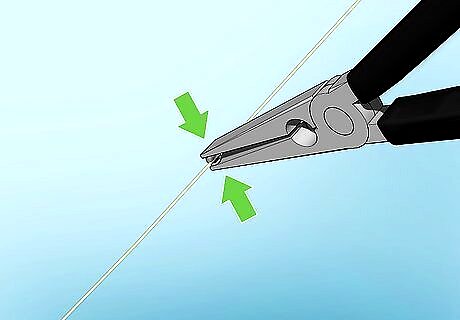
Pinch the weights onto the line with needlenose pliers. Hold the weight in place with one hand and use your pliers with the other. Gently squeeze the sides of the weight until it closes around the line. If you don’t have needlenose pliers, try pinching the weight closed with your fingers. Be careful not to squeeze the sides completely closed since that could damage the line. Try squeezing them until they’re barely touching, then test if the line is secure.
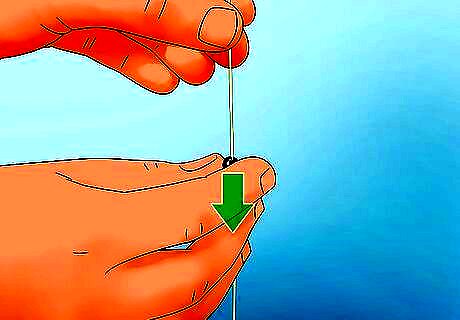
Tug on the line to make sure the sinker doesn’t move. Hold the weight with one hand and the fishing line with the other. Lightly pull on the line and watch if it slides through the weight. If the line still moves, then pinch the weight a little tighter around it. If you need to reposition the weight because it moved, just pinch the opposite side to release it from your line.
Rubber Core Sinkers
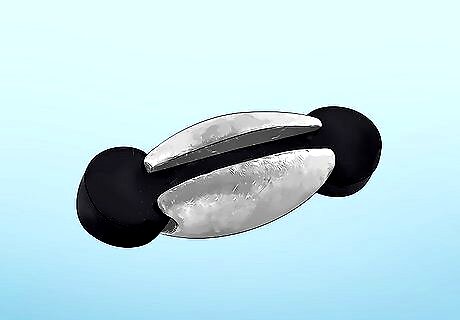
Use rubber core sinkers to quickly add more weight than a split shot. Rubber core sinkers are long metal cylinders with a slit on one side and a rubber center. They’re slightly larger than split shot weights, so they let you fish in deeper water. Since they’re easy to attach to your line, you can put them on and take them off without untying any knots.
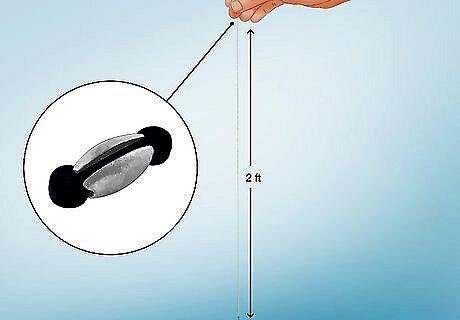
Attach the sinker about 2 ft (0.61 m) above the hook. Leaving space between the sinker and hook helps your bait float up so it’s more visible to fish. Measure up from the top of your hook and pinch the line so you don’t lose your place. Positioning your sinker much higher on your line may make it difficult to cast.
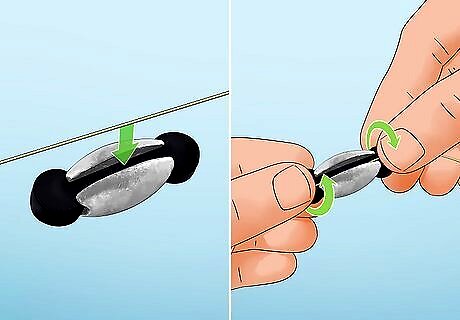
Push the line into the slot and twist on the sinker. Look for the opening with rubber on one side of the sinker. Hold the line tight and feed it into the slot so it wraps around the line. Grab the rubber ends of the sinker and twist them in opposite directions to secure it to the line. The motion to secure your line is similar to unwrapping a candy wrapper. If you want to remove or reposition the sinker, untwist the rubber and gently pull the line out from the rubber.
Sliding Sinkers
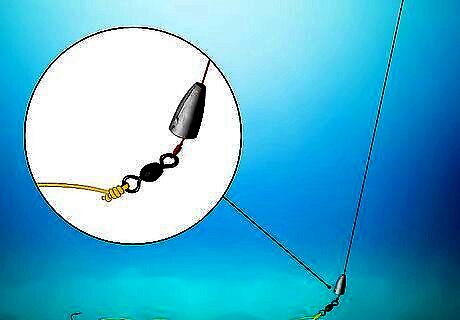
Fish with a sliding sinker to reach the bottom of the water. Sliding sinkers come in many shapes, like eggs and bullets, and they have a hole running through the middle. They weigh your line down so your bait floats just below the bottom. When a fish strikes your bait, the sinker moves along the line so the fish doesn’t feel resistance and spit out the hook. Egg sinkers work really well when you’re casting in windy conditions. Bullet sinkers are a little heavier than egg sinkers, so they’re best for catching larger fish in deep water.
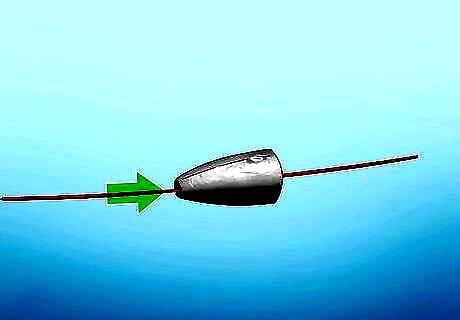
Slide the sinker onto the main line running back to your reel. Make sure your line is already threaded through your reel and rod so you’re ready to fish right away. Since sliding sinkers can move freely up and down your line, just feed the line through the hole in the middle of the weight. Remember to use a line that’s meant for the type of water where you’re fishing.
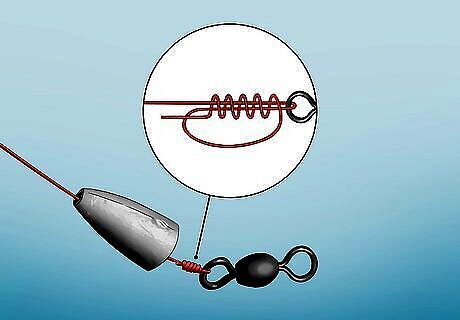
Tie the main line to a swivel with a uni knot. A swivel is a metal piece with eyelets that you attach to the end of your line so you can easily change your fishing rigs. To make a uni knot, feed about 6 in (15 cm) of line through an eyelet on the swivel so the line is doubled up. Then, wrap the end around the doubled-up lines 5 or 6 times before pulling it tight through the loop. Make sure that the sinker can’t slide over and off of the swivel. If it can, then slide a stop bead onto the line before adding the swivel.
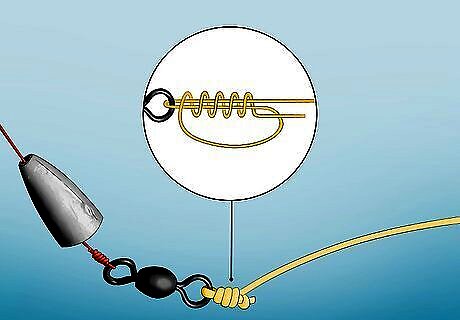
Attach a leader with your hook and bait to the swivel. A leader is a 12–18 in (30–46 cm) piece of line that you can easily add to the end of your main line. Use a uni knot to tie one end of the leader to the other eyelet on the swivel. Then, tie a clinch knot to attach the hook for your bait. The leader will float higher than the sinker, so it’s less likely to get caught on any weeds along the bottom.
Ring Loop (Tied) Weights
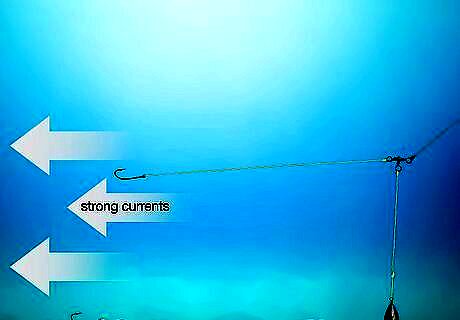
Stick to tied weights for fishing in deep water or strong currents. Tied ring loop weights are shaped like a pyramid or large ball with a metal ring on top. Since they’re the heaviest weights, they quickly sink to the bottom and stay put. That way, the current won’t make your line drift away. You can use tied weights whether you’re fishing from the shore or a boat.
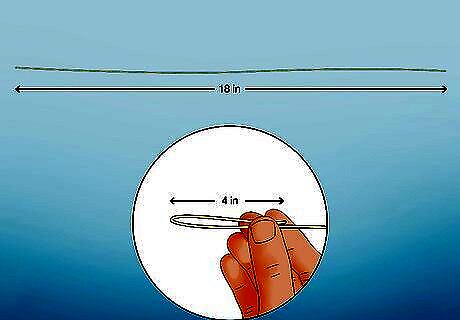
Form a 4 in (10 cm) loop at the end of a leader line. Attaching your sinker with a separate section of line makes it easier to remove and replace than putting it on your main line. Take a piece of line that’s about 18 inches (46 cm) long. Fold one end of the line over by 4 inches (10 cm) to make your loop.
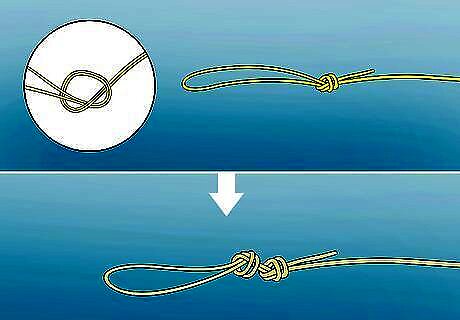
Tie 2 overhand knots to secure the loop in place. Hold the end of the line that’s folded over between your fingers so it doesn’t move around. Take the looped end of the line and tie your overhand knots. Pull the line tight so it doesn’t come undone. If there’s any excess line sticking out from the knot, trim it off with a pair of scissors.
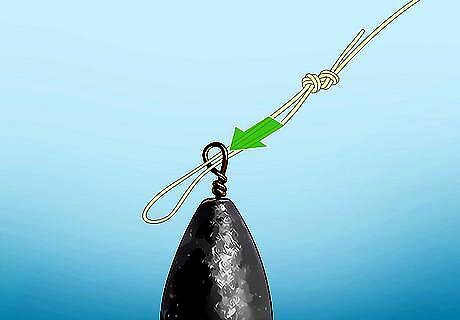
Feed the loop through the ring on the weight. Pinch the loop in your line and pull it straight through the ring on top of the weight. It’s okay if the knot slides through the ring right now.
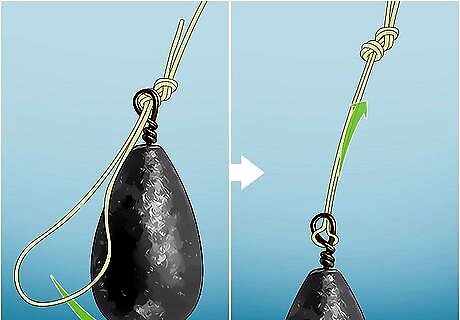
Pull the loop over the weight and pull it tight to the line. Guide the loop around the bottom of the weight and pull it back up towards the ring on top. The line will tightly wrap around itself at the top of the ring so nothing in the water makes your weight come free. If you ever want to change the weight, just slide the loop back over the bottom and pull the line out from the ring.
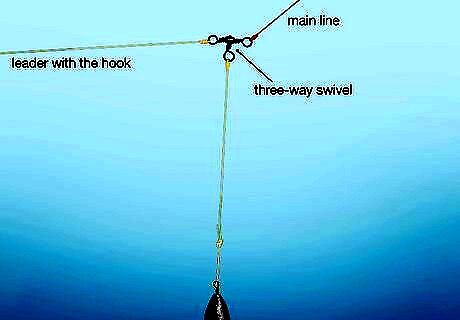
Attach the weighted line to a three-way swivel on your main line. A three-way swivel has 3 eyelets: one for the main line, one for the leader with the hook, and one for your leader with the weight. Tie a uni knot to connect the end of the weighted leader to one of the swivel’s eyelets.



















Comments
0 comment